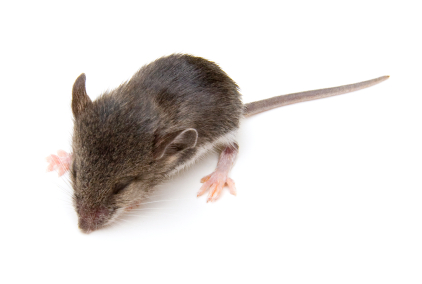Biology and Life Habits

Mice are common in all parts of Canada. We have taken on ourselves the task of dealing with the mice in Ontario towns such as Toronto, Whitby, Oakville, Mississauga, Pickering and Ajax. The mouse most commonly encountered is the house mouse. The house mouse is light gray in colour and measures from 110 to 150 mm (4” to 6”), with large ears and long tails.
Usually invasions occur in the fall because of the cooler weather and lack of food source. Mice are excellent climbers and are capable of entering any building through any hole that is the size of a dime (1/4”) or larger.
Mice are nibblers and thus tend to make small holes or other slight damage in many places rather than a lot of damage at one place. They may feed as often as 15 to 20 times each day and do not require a daily source of water. They can get their daily water requirements from the food source they are feeding on.
The average lifespan of a house mouse is 12 months. A single female mouse may have as many as eight litters per year, averaging five to six young in each litter. Within 3 months time the young can start reproducing as well.
Questions and Answers
Q – How can I tell if I have an infestation of mice?
A – There are several ways that mice make their presence known. Mouse droppings near available food is the most common indication. Gnawed holes in bags and boxes containing food or garbage is also a sign of mouse activity.
Q – Do mice die off in cold months? How can I tell if I have an infestation of mice?
A – No. Mice can survive outdoors during the winter under certain conditions, but generally invade buildings when the weather turns cold.
Q – What can I do to prevent an infestation of mice?
A – Since the contributing factor to a mouse infestation is the presence of food, good housekeeping is essential. This includes the proper storage of foods in sealed jars or tins. In addition all refuse should be store in containers with tight fitting lids. Seal all openings to the outside, especially around doors and windows.
Q – Do mice cause damage?
A – Yes. Mice cause extensive damage to houses, granaries, restaurants, bakeries – any place food is handled or stored. They will gnaw through wood to gain entrance into buildings. In constructing their nests mice will destroy fabrics and leather goods and can cause fires by chewing through the insulation on electrical wires.
Q – Are mice hazardous to humans?
A – Yes. Mice contaminate food with their droppings and urine. They spread such diseases as salmonella bacteria (food poisoning), leptospirea (jaundice) and typhus. As well, they carry parasites such as fleas, roundworms and mites. A bite inflicted by a mouse should receive prompt medical attention.
Q – When are mice most common?
A – Mice are year-round pests. Activity and indoor migration increases as weather gets cooler.
Q – When am I most likely to see mice?
A – Mice become active primarily during the evenings and remain so until the middle of the night. If food is scarce or the infestation is large, they will be active during daylight hours.
Q – Where do mice build nests?
A – Mice nest in any safe location close to food, preferring the spaces in double walls, between ceilings and floors and closed in areas around counters. Noises made by their running, gnawing and scratching will provide clues to their actual location.
Q – Do mice travel outside in search of water once they eat the bait?
A – No. This is an old wive’s tale. Mice that eat the bait usually die in inconspicuous locations, attics, wall voids, ect.
Preparation Guidelines for Mice Treatment
Eliminate any food source and plug any holes or openings where mice may gain entry to the home.
If the mice are in the cupboards or closets, these areas should be cleared out so that control measures can be installed.
Children and pets should not be allowed to tamper with the control devices.
Reliable is very safety conscious, and may use glue boards, snap-traps, and live traps. These items are placed in areas that are as “out of the view” of residents as possible. If these devices are found, please do not move or touch them.
If rodenticide bait is used, it is placed in locked stations in areas that are as inaccessible to children as possible. Please do not move or touch these stations. which have been set to take care of Mice Ajax, Mice Whitby and their neighbors.
Reliable will return after the extermination has been completed to remove all baits and traps. This should be arranged prior to service. If no arrangement has been made, the home owner can dispose of control devices after the mouse activity has ceased.
